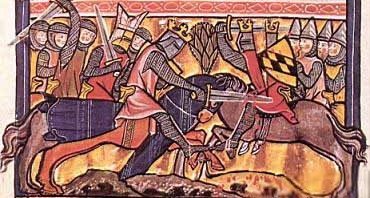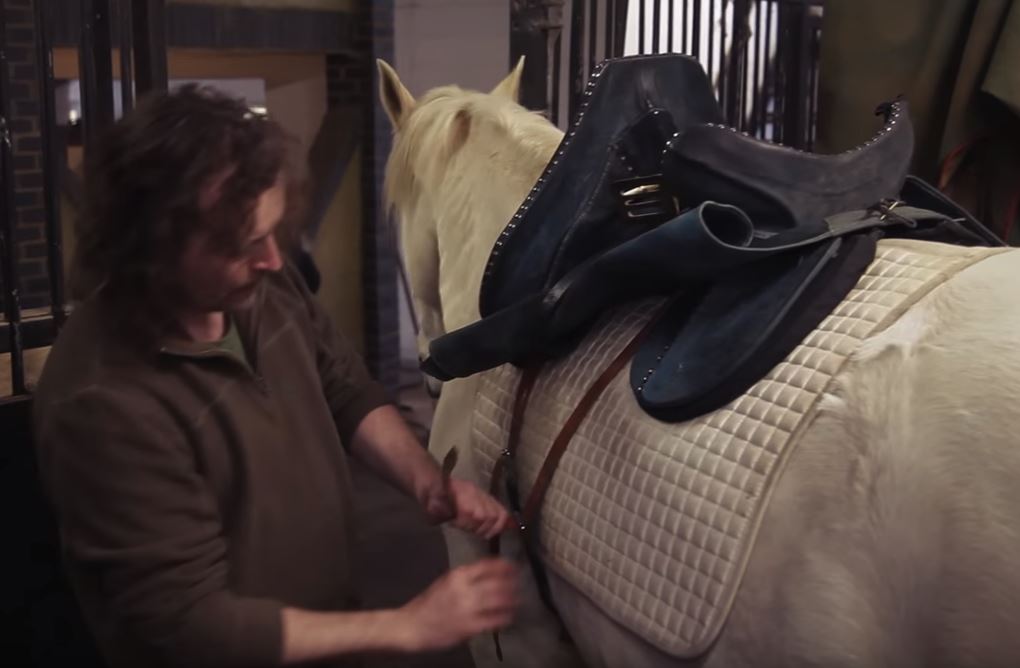Between Knighthood and Game Development : Interview with Jason Kingsley
Kingsley and his gelding Warlord
To say that Jason Kingsley leads an interesting life is quite the understatement: Kingsley is the CEO and co-founder of successful game development company Rebellion, and chairman of The Independent Game Developer’s Association. He owns 15 horses and trains them in medieval style riding. He and his horses have starred in a variety of documentaries, medieval style tournaments and photo shoots. In 2012, he was awarded an Order of the British Empire for his service to the Economy.
As an expert on both medieval horsemanship and game development, Jason Kingsley made for an incredibly fitting interview partner for The Mane Quest.
Humble Beginnings
So how does one become CEO of a successful game development company and find time to pursue knighthood in one’s free time? Kingsley says he has always tried to arrange his business life around what he wants to do, and that he has been pretty successful so far in doing just that.
His work with horses started early: “I managed to persuade my parents to give up foreign holidays and instead buy me a pony when I was 8 years old, and have never looked back. There have been a handful of years when I haven’t had a horse in my life, but only a handful.“ Kingsley turns 54 this year.
Kingsley says that myths, legends and science fiction have all been major drivers for him and his work. In a documentary about Medieval Mounted Combat that Rebellion produced in 2015, he calls himself “a historian with a deep, practical interest in the Middle Ages.”.
Rebellion Developments was founded in 1992 by Jason Kingsley and his brother Chris. Nowadays, the company is perhaps best known for Sniper Elite, a series of World War II first person shooter games.
“Chris and I get involved in all the games we make right from the start, and all the way through,” Kingsley tells The Mane Quest. “These days we have well over 300 full time staff helping us out, but back in the beginning, it was just the two of us making games.”
In a 2016 interview with the Evening Standard, Kingsley said that meetings and keeping track of projects within the company consume a lot of his work time.
Kingsley and Warlord, with costume and banner
Knightly Riding
Kingsley owns fifteen horses, including three stallions and several youngsters that have been born and bred in his care.
Although he says that his particular area of interest is the warhorse, or stallion trained for battle, Kingsley’s star horse and most experienced companion is a Lusitano gelding by the name of Warlord. “Warlord was gelded very late, so he behaves a bit like a stallion but lacks the muscular neck.”
Gelding (i.e. castrating) male horses is a practice that goes back over two thousand years and has been practiced by many — though not all — horse-using cultures around the world. Geldings are generally easier to handle and less driven by their hormones than stallions.
“Stallions, geldings and mares are all wonderful to work with,” Kingsley tells me. “I find stallions can be impulsive and mares can be changeable, whereas geldings are pretty stable over all usually.”
Knights in the west would likely have ridden stallions, Kingsley estimates, whereas mares were more popular mounts in eastern cultures. The practice of gelding was historically rare in Arab horses, for example, where stallions were kept in bachelor herds while mares were used for riding.
13th Century illustration of mounted combat. Note the knights’ long, almost straight legs.
Medieval horse riding differs from other popular riding styles such as English or Western riding in various ways. “The saddles are designed to keep your body upright and your legs long, so jumping is an issue.”
Kingsley tells me that in training a warhorse, collection is important, as is explosive power to accelerate towards a target.
Collection is by no means unique to medieval riding, but an important aspect of horsemanship in general — the term refers to a horse carrying more weight on its hind legs than its front legs, which is desireable not only for more controlled riding, but also for the horse’s well-being in carrying the weight of a rider.
A warhorse needs to remain calm when dealing with armor, flags and noise. Kingsley patiently trains his steeds for such situations — a process he documents on his Facebook page and in his “Modern History TV” YouTube Series.
Here, Kingsley uses a replica of a 15th century saddle, designed to distribute a knight’s weight with armor better than a modern saddle. Src
Talos is a Shire x Andalusian stallion that Kingsley is working with. Pictured here with his brand new medieval style bridle.
Ghost, a Lusitano stallion, is getting used to the weight and noise of armor, one piece of equipment at a time.
Gossamer, a young mare, being trained to rear on command with the weight of a rider.
Kingsley tells me that the areas of game development and horse training normally only overlap when it comes to PR and marketing. “Journalists love the idea of taking a picture of me in armour on a horse to illustrate their article on the games industry,” he tells me.
With how much I’ve enjoyed my research into Kingsley’s horse work, I can hardly blame them for that. “It’s nice to be able to talk about both high tech and medieval tech in the same interview", he adds, referring to such conversations.
Medieval Motion Capture
Beyond that, Kingsley’s work as knight and game developer have come together in one particular project: Joust Legend, a mobile game about medieval tournaments. In it, the player takes on the role of a knight and participates in jousting matches. The twist: The movements of horse and rider in the mobile game were motion captured from Kingsley himself and Warlord.
“Doing motion capture is quite an odd experience,” Kingsley tells me when asked about the process. “Both me and Warlord had to be encased in lycra with reflective dots at certain places.”
This did not only make the white horse look like a black one, but also caused some worry about overheating, Kingsley says. “Also the lycra is quite slippery against the saddle so that was not fun either. Warlord tends to get worked up the longer the shoot goes on, so we did the slow stuff first, then went for the more active crazy stuff at the end.”
The effort proved to be worth it for the game, in Kingsley’s estimate, to get the authenticity of movement. “We’ve all seen actors pretend riding horses, and anybody who knows anything about riding can instantly tell they’re not actually on a horse at all. Seeing Warlord’s movement on a computer generated horse was a lot of fun. You can recognise both him and me in the game easily.“
All in all, Kingsley says Joust Legend was a big success for Rebellion. “It was somewhat experimental and taught us some things to do in the future,” he says. “Maybe it was a little too niche though?“
Horses in Games
Kingsley and Warlord dressed up as Richard III and his horse White Surrey
When I first contacted Jason, I asked him what he thinks games usually get wrong about horses. His reply was “almost everything”.
Although Kingsley says he has never played a game where he is fully happy with the horses, he does enjoy games about medieval fantasy warfare a lot. Kingdom Come: Deliverance and Mount & Blade: Warband interest him, but he hasn’t played either for long: “I’m just too busy with the real thing!“
Obviously, horse riding is a complex topic, but I wanted to know if there was anything Kingsley thought games could get right if they wanted to. “Movement,” was his response. “Anybody who rides to a certain level knows about collection and transitions and lateral work.”
For the non-riders reading along: ‘transitions’ refers to changing gaits, switching from a walk to a trot or a trot to a canter et cetera, a common exercise in various riding styles. Lateral movement is any movement other than straight forward, and collection is the aforementioned concept of engaging the hindquarters for a healthier and more balanced movement.
Kingsley and Ghost
Kingsley thinks part of the issue is that animators look for references in the wrong places without realizing that there are differences between areas and styles: “I’ve lost count of the number of times I've had to nudge an animator to ignore the wrong style of horse riding. For example, they may reference western loping in a game of high school dressage. If you don’t know horses, it’s all just horses, but there are huge differences in the different disciplines of various areas of equestrianism.”
This variety in style would also make it difficult to make a horse game that appeals to a wide enough market, Kingsley believes.
Personally, I would love to play a realistic game about medieval riding or Spanish riding or Western riding even though those are not the disciplines I’m most familiar with, but Kingsley suspects that these stylistic differences might further divide an already niche market.
“All share the core values of making the horse perform well and comfortably though,” he adds.
Rebellion does not currently have any plans to get into the horse game market, Kingsley says. “But it’s always on my mind. You never know, perhaps one day?”
The Mane Quest remains hopeful.
Jason Kingsley posts about his horses and his games on Facebook and Twitter. His documentary series Modern History TV can be found on YouTube. I also recommend this video on Medieval Mounted Combat, where he demonstrates authentic techniques.
Unless otherwise labelled, the photos in this article were taken from Jason’s facebook page with his permission.














Rival Stars Horse Racing is something of a rarity in our niche: it’s a polished game aimed at adult players, that’s generally well received and getting regular content updates. For the game’s five year anniversary, I sat down for a call with PikPok CEO Mario Wynands in order to talk about the game’s history, its position in the horse game market and why it takes different approaches to different platforms.